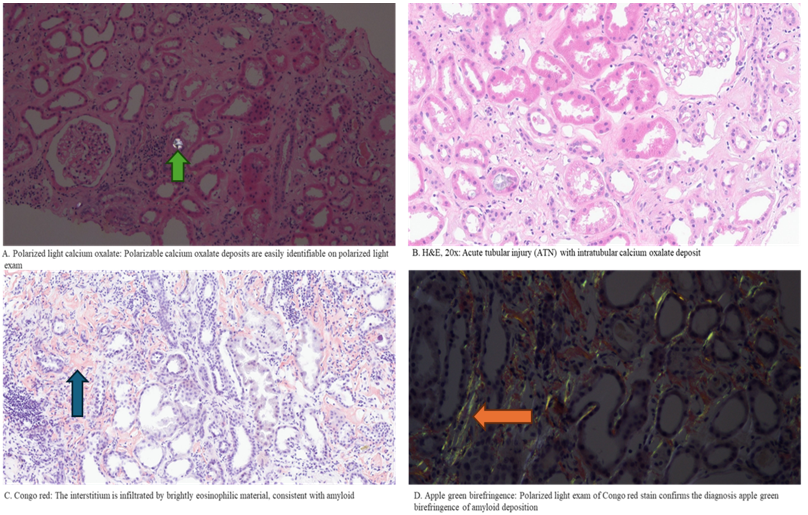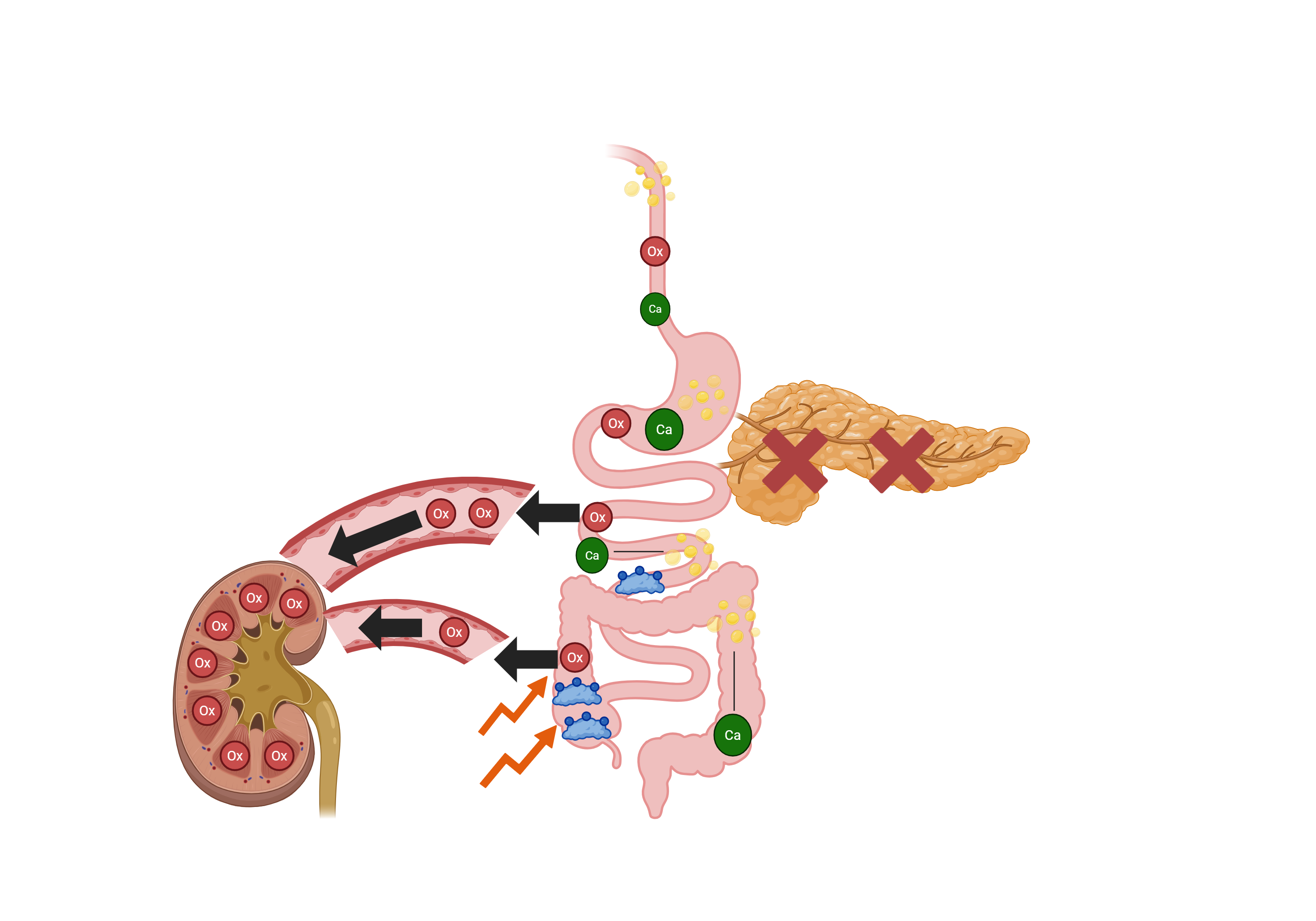Tuesday Poster Session
Category: Biliary/Pancreas
P4382 - Pancreatic Enzyme Therapy Nonadherence in a NET Patient: A GI Cause of Renal Injury
Tuesday, October 28, 2025
10:30 AM - 4:00 PM PDT
Location: Exhibit Hall
- FJ
Fares Jamal, MD (he/him/his)
Mayo Clinic
Phoenix, AZ
Presenting Author(s)
Fares Jamal, MD1, Jason S. Starr, MD2, Thor R. Halfdanarson, MD3, Maggie S. Ryan, MD4, Amani Elshaer, MBBS1, Musab S. Hommos, MBBS1, Mohamad Bassam Sonbol, MD1
1Mayo Clinic, Phoenix, AZ; 2Mayo Clinic, Jacksonville, FL; 3Mayo Clinic, Rochester, MN; 4Mayo clinic arizona, Scottsdale, AZ
Introduction: Pancreatic exocrine insufficiency (PEI) is an often overlooked cause of chronic diarrhea in patients with neuroendocrine tumors (NETs), particularly those treated with somatostatin analogues (SSAs). If unrecognized or untreated, PEI can lead to significant nutritional deficiencies and complications such as oxalate nephropathy (ON), a rare but serious cause of kidney injury. This can in turn limit the use of critical oncologic therapies like peptide receptor radionuclide therapy (PRRT), which requires preserved renal function.
Case Description/
Methods: A 67-year-old male with a metastatic small bowel NET presented with chronic diarrhea of several years’ duration. The diarrhea was multifactorial, attributed to carcinoid syndrome [elevated plasma 5-hydroxyindoleacetic acid (5-HIAA) at 613 ng/mL], bile acid malabsorption (elevated blood 7α-C4 at 154 ng/mL), and PEI (reduced pancreatic elastase in stool at 66 mcg/g) secondary to long-term SSA use. PEI was identified based on clinical features and fecal elastase testing. Although pancreatic enzyme replacement therapy (PERT) was prescribed, the patient could not afford consistent use due to high out-of-pocket costs. Later, he developed worsening renal function, and a kidney biopsy revealed extensive oxalate crystal deposition, consistent with oxalate nephropathy. As a result, he was deemed ineligible for PRRT due to reduced kidney function, limiting his treatment options.
Discussion: This case underscores the importance of early recognition and management of PEI in patients with NETs, especially those on SSAs. While diarrhea in these patients is often multifactorial, PEI should not be overlooked as a contributing cause. Failure to adequately treat PEI can lead to fat malabsorption, enteric hyperoxaluria, and eventually oxalate nephropathy. In this patient, inconsistent access to PERT due to financial barriers likely played a central role in the development of renal injury. This not only impacted his overall health but also restricted access to further oncologic therapy. Clinicians should have a low threshold to evaluate for PEI in NET patients with ongoing diarrhea, and efforts should be made to ensure access to affordable enzyme therapy. Early and adequate treatment may help avoid long-term complications and preserve eligibility for life-prolonging therapies like PRRT.

Figure: In this model, the pancreas (marked with an "X" symbol) does not function, impairing fat digestion and bile acid reabsorption. As a result, calcium (Ca) binds to undigested fat droplets (yellow circular structures) instead of forming complexes with oxalate. Consequently, oxalate (Ox) is absorbed into the bloodstream. In addition, unabsorbed bile acid (blue structure) stimulates (orange arrow) the colon to increase oxalate (Ox) absorption into the bloodstream. The excess oxalate then deposits in the kidneys, contributing to the development of oxalate nephropathy

Figure: Figure 2: Histopathologic Features of Calcium Oxalate and Amyloid Deposition in Renal Biopsies
(A-D) Renal biopsy images. (A): green arrow pointing to the calcium oxalate deposits, (C): blue arrow pointing to the eosinophilic material, (D): orange arrow pointing to the amyloid deposits.
Disclosures:
Fares Jamal indicated no relevant financial relationships.
Jason S. Starr: Amgen – Grant/Research Support. Arcus Biosceince – Grant/Research Support. Boehringer-Ingelheim – Consultant, Grant/Research Support. Camurus Therapeutics – Grant/Research Support. Cardiff Oncology – Grant/Research Support. Exelixis – Consultant. Perspective Therapeutics – Grant/Research Support. RayezBio – Grant/Research Support.
Thor R. Halfdanarson indicated no relevant financial relationships.
Maggie S. Ryan indicated no relevant financial relationships.
Amani Elshaer indicated no relevant financial relationships.
Musab S. Hommos indicated no relevant financial relationships.
Mohamad Bassam Sonbol indicated no relevant financial relationships.
Fares Jamal, MD1, Jason S. Starr, MD2, Thor R. Halfdanarson, MD3, Maggie S. Ryan, MD4, Amani Elshaer, MBBS1, Musab S. Hommos, MBBS1, Mohamad Bassam Sonbol, MD1. P4382 - Pancreatic Enzyme Therapy Nonadherence in a NET Patient: A GI Cause of Renal Injury, ACG 2025 Annual Scientific Meeting Abstracts. Phoenix, AZ: American College of Gastroenterology.
1Mayo Clinic, Phoenix, AZ; 2Mayo Clinic, Jacksonville, FL; 3Mayo Clinic, Rochester, MN; 4Mayo clinic arizona, Scottsdale, AZ
Introduction: Pancreatic exocrine insufficiency (PEI) is an often overlooked cause of chronic diarrhea in patients with neuroendocrine tumors (NETs), particularly those treated with somatostatin analogues (SSAs). If unrecognized or untreated, PEI can lead to significant nutritional deficiencies and complications such as oxalate nephropathy (ON), a rare but serious cause of kidney injury. This can in turn limit the use of critical oncologic therapies like peptide receptor radionuclide therapy (PRRT), which requires preserved renal function.
Case Description/
Methods: A 67-year-old male with a metastatic small bowel NET presented with chronic diarrhea of several years’ duration. The diarrhea was multifactorial, attributed to carcinoid syndrome [elevated plasma 5-hydroxyindoleacetic acid (5-HIAA) at 613 ng/mL], bile acid malabsorption (elevated blood 7α-C4 at 154 ng/mL), and PEI (reduced pancreatic elastase in stool at 66 mcg/g) secondary to long-term SSA use. PEI was identified based on clinical features and fecal elastase testing. Although pancreatic enzyme replacement therapy (PERT) was prescribed, the patient could not afford consistent use due to high out-of-pocket costs. Later, he developed worsening renal function, and a kidney biopsy revealed extensive oxalate crystal deposition, consistent with oxalate nephropathy. As a result, he was deemed ineligible for PRRT due to reduced kidney function, limiting his treatment options.
Discussion: This case underscores the importance of early recognition and management of PEI in patients with NETs, especially those on SSAs. While diarrhea in these patients is often multifactorial, PEI should not be overlooked as a contributing cause. Failure to adequately treat PEI can lead to fat malabsorption, enteric hyperoxaluria, and eventually oxalate nephropathy. In this patient, inconsistent access to PERT due to financial barriers likely played a central role in the development of renal injury. This not only impacted his overall health but also restricted access to further oncologic therapy. Clinicians should have a low threshold to evaluate for PEI in NET patients with ongoing diarrhea, and efforts should be made to ensure access to affordable enzyme therapy. Early and adequate treatment may help avoid long-term complications and preserve eligibility for life-prolonging therapies like PRRT.

Figure: In this model, the pancreas (marked with an "X" symbol) does not function, impairing fat digestion and bile acid reabsorption. As a result, calcium (Ca) binds to undigested fat droplets (yellow circular structures) instead of forming complexes with oxalate. Consequently, oxalate (Ox) is absorbed into the bloodstream. In addition, unabsorbed bile acid (blue structure) stimulates (orange arrow) the colon to increase oxalate (Ox) absorption into the bloodstream. The excess oxalate then deposits in the kidneys, contributing to the development of oxalate nephropathy

Figure: Figure 2: Histopathologic Features of Calcium Oxalate and Amyloid Deposition in Renal Biopsies
(A-D) Renal biopsy images. (A): green arrow pointing to the calcium oxalate deposits, (C): blue arrow pointing to the eosinophilic material, (D): orange arrow pointing to the amyloid deposits.
Disclosures:
Fares Jamal indicated no relevant financial relationships.
Jason S. Starr: Amgen – Grant/Research Support. Arcus Biosceince – Grant/Research Support. Boehringer-Ingelheim – Consultant, Grant/Research Support. Camurus Therapeutics – Grant/Research Support. Cardiff Oncology – Grant/Research Support. Exelixis – Consultant. Perspective Therapeutics – Grant/Research Support. RayezBio – Grant/Research Support.
Thor R. Halfdanarson indicated no relevant financial relationships.
Maggie S. Ryan indicated no relevant financial relationships.
Amani Elshaer indicated no relevant financial relationships.
Musab S. Hommos indicated no relevant financial relationships.
Mohamad Bassam Sonbol indicated no relevant financial relationships.
Fares Jamal, MD1, Jason S. Starr, MD2, Thor R. Halfdanarson, MD3, Maggie S. Ryan, MD4, Amani Elshaer, MBBS1, Musab S. Hommos, MBBS1, Mohamad Bassam Sonbol, MD1. P4382 - Pancreatic Enzyme Therapy Nonadherence in a NET Patient: A GI Cause of Renal Injury, ACG 2025 Annual Scientific Meeting Abstracts. Phoenix, AZ: American College of Gastroenterology.
